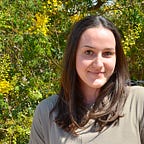Bite-size Biomimicry: Aspens
What can we learn from Aspens about capturing energy in different conditions?
Quaking aspens (Populus tremuloides) are found primarily in higher elevation mountain ecosystems, although they are the most widely-spread tree species in North America. They are more common the farther north you go, but the cold weather and wind don’t bother this hardy organism at all.
The leaves of Aspen “tremble” even in the smallest breeze, because it’s leaves are connected to the branch with long, laterally-flattened petioles that are perpendicular to the plane of the leaf. This allows the leaves to move easily and efficiently despite airflow frequency or intensity. Most tree species have circular petioles, the Aspen’s flattened petiole is very unique. Additionally, even when these leaves are shed for the winter months, the bark can continue photosynthesizing and produce sugars for energy. This is because its bark is living tissue, which is unique among North American trees (and one of the many reasons not to carve your initials into it!).
Bonus fun fact: Because Aspens are clonal and can reproduce by sending up new offspring trees via their root system, they grow in large patches that are all related to each other. These clonal groups will change their leaf color at the same time. There is one stand of aspen in Utah (named Pando) that is about 100 acres in size. It consists of roughly 47,000 trees, all of which are genetically identical. This stand is believed to be the largest living organism in the world!
Learn more about Aspen habitat, structure, and reproduction here.
Watch my TikTok video exploring Aspens here.
My question for you: how can we translate these efficient strategies to human design? Let me know in the comments!
